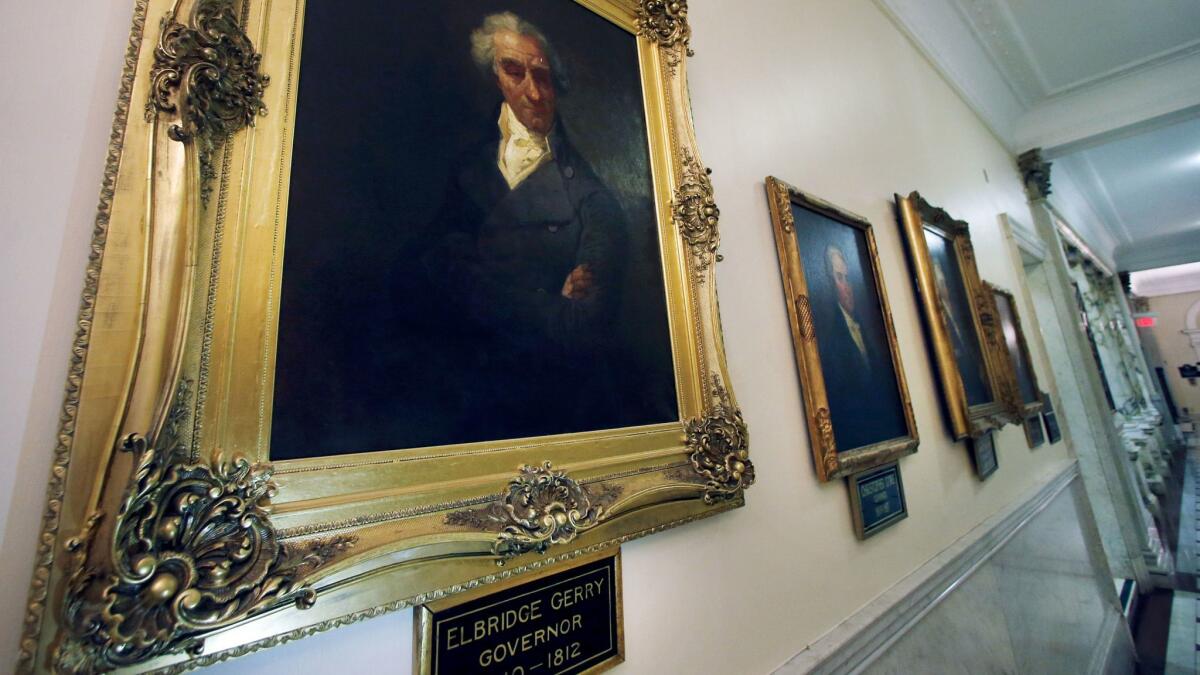Analysis: In gerrymander case, Supreme Court takes on long history of brazen political self-dealing

- Share via
Reporting from WASHINGTON — Gerrymandering, the practice of drawing self-serving political boundaries, is as old as the country itself. Its impetus, one could argue, is even older and deeper-seated, grounded in the fundamentals of human nature.
In the zero-sum game of campaigns and elections, where you either win or lose, gerrymandering is a way to stack the deck and improve the odds by sorting people into districts based on how they are expected to vote — in what, up to now, has been perfectly legal fashion.
By agreeing to hear a landmark case challenging the drawing of strongly partisan boundaries in Wisconsin, the U.S. Supreme Court indicated Monday that it will consider whether, finally, enough is enough.
If the court, which takes up the case in the fall, rules that partisan gerrymandering is unconstitutional — a very big if, experts say — it could drastically change the country’s politics by injecting much greater competition into races for Congress and for statehouses nationwide.
Such a decision probably would also spawn years, if not decades, of further litigation, spurring politicians in the meantime to find ever more clever ways of skewing contests for partisan advantage.
“Drawing fair districts is a little like drawing a fair tax plan,” said Justin Levitt, a constitutional scholar at Loyola Law School in Los Angeles. “A lot of people have very different ideas what those should look like at the end of the day.”
Some, for instance, think it’s perfectly legitimate and beneficial to group communities of interest — say, Latinos or city dwellers or workers concentrated in the high-tech industry. Others desire geographical compactness or a strict adherence to county or municipal lines.
Up to now, if there has been a set of principles that guides the political line-drawing process, they are: Maximize your political advantage. Do whatever you can get away with.
“Most politicians, if they have the opportunity, they want to win reelection, they want to be in the majority,” said Michael McDonald, a University of Florida political scientist who has testified as an expert in lawsuits challenging political boundaries. “So why would they not take advantage, given the opportunity?”
Unlike in other countries, the process of drawing electoral lines in the U.S. has largely been left in the hands of those elected to represent those districts. It did not take long for inherent conflicts of interest to arise.
No less an eminence than Patrick Henry — of “Give me liberty or give me death” fame — worked to persuade the Virginia legislature to draw congressional boundaries aimed at politically rubbing out another of the country’s founders, his enemy James Madison. Madison won the congressional seat despite Henry’s efforts and went on to become president.
As events would have it, one of two vice presidents who served under Madison was Elbridge Gerry, the former governor of Massachusetts whose creative, nakedly partisan line drawing produced a district resembling a salamander, hence his enduring contribution to the nation’s political lexicon: the gerrymander.
His modern disciples, including California’s legendarily powerful Rep. Phil Burton, were unapologetic in their own brazen biases. The San Francisco Democrat, who almost single-handedly engineered his party’s congressional dominance in the state in the 1980s, proudly described his twisting, blatantly partisan political lines as “my contribution to modern art.”
All Republicans could do was stew.
Now it is Democrats who object the loudest, as the GOP has used its sizable advantage in governorships and statehouses to craft the greater portion of the nation’s political map, and do so in the most beneficial way possible
In the Wisconsin case before the Supreme Court, Republican Gov. Scott Walker and his allies drew a map that won the GOP 60 of 99 Assembly seats, even though in 2012 Republicans won less than half — 48.6% — of the two-party legislative vote.
At the national level, Democrats won a plurality of the congressional vote in 2012 but, because of the way lines were drawn, failed to win enough seats to take control of the House.
Their effort to win the House in 2018, amid a hoped-for backlash against President Trump, may be similarly hampered by strategically drawn districts that tilt toward the GOP; at the least, any wave that sweeps Democrats into office will have to be substantially stronger than it might otherwise.
The lopsidedness arguably contributes to the nation’s polarization; for many lawmakers, the greatest fear is a primary challenger professing greater ideological purity — though the Senate, where lawmakers are elected statewide, is not exactly a bastion of bipartisan group hugs.
If change in the redistricting process comes, it will most likely be from the bottom up, from efforts like those in California, where voters took the line drawing away from politicians and handed the process to a commission that, at least in theory, was a neutral arbiter.
Similar attempts are underway across the country and ultimately may prove a more effective brake on gerrymandering than the Supreme Court.
Whatever the justices decide, said the University of Florida’s McDonald, politicians will doubtless continue to try to manipulate the system to the greatest extent they can. “There’s absolutely no incentive not to,” he said.
Given how things work, lawmakers can draw new district lines after the 2020 census and probably wait years for the courts to get around to reviewing their handiwork. By then, they’ll be firmly entrenched incumbents with a big head start on reelection until the next redistricting takes place.
ALSO
Supreme Court rules the Slants may trademark their name, striking down law banning offensive terms
Shooting heightens lawmakers’ security fears amid growing partisan rancor
More to Read
Get the L.A. Times Politics newsletter
Deeply reported insights into legislation, politics and policy from Sacramento, Washington and beyond. In your inbox twice per week.
You may occasionally receive promotional content from the Los Angeles Times.











